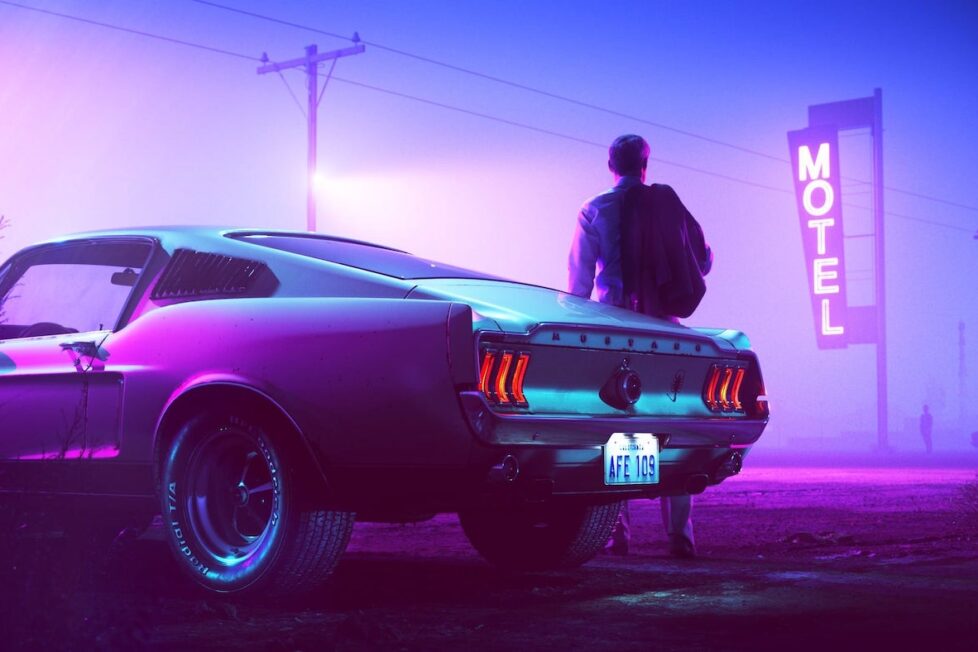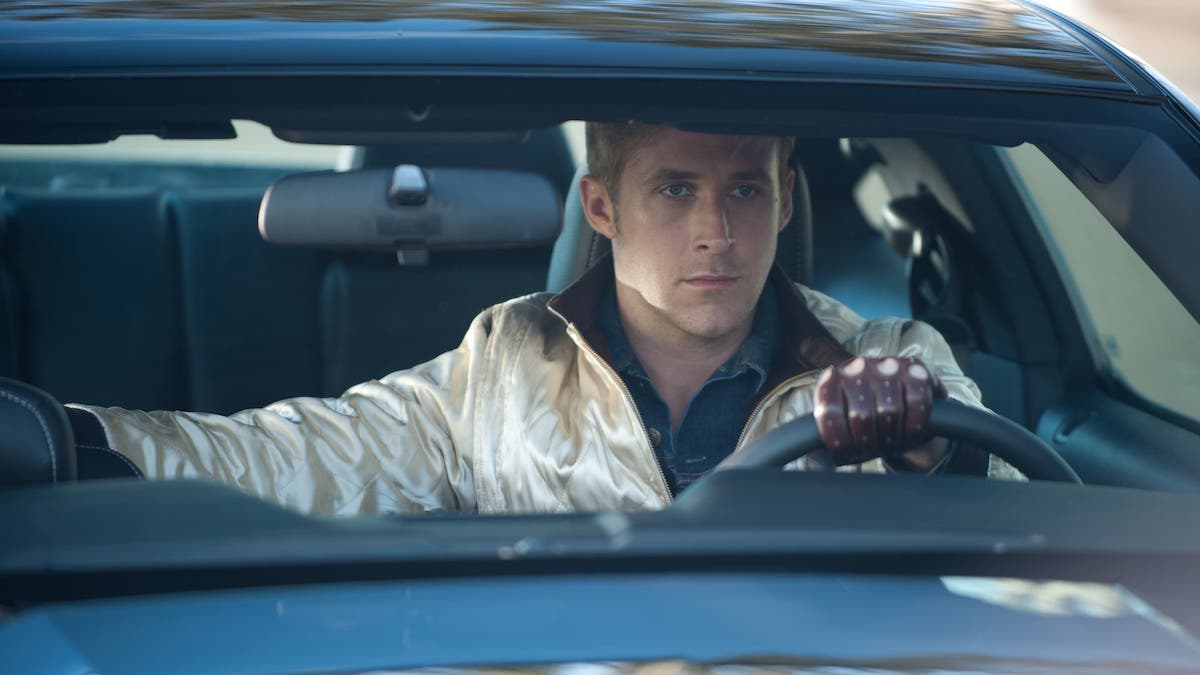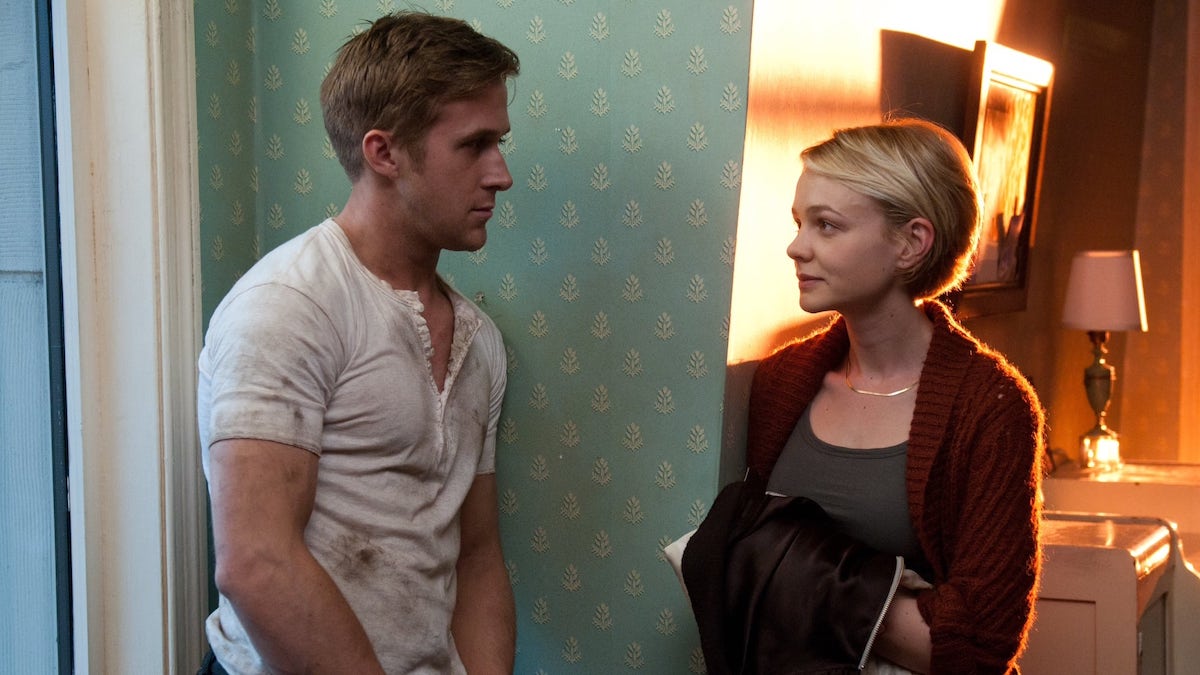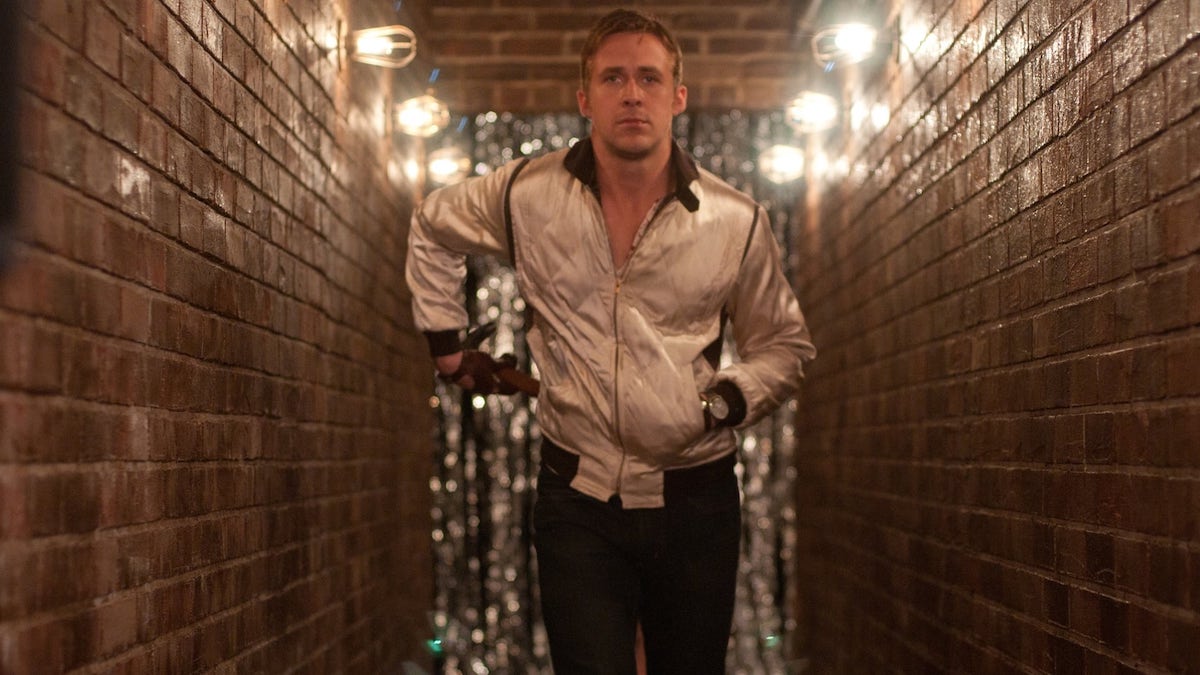DRIVE (2011)
A mysterious Hollywood stuntman and mechanic, who moonlights as a getaway driver, finds himself in trouble when he helps out his neighbour.

A mysterious Hollywood stuntman and mechanic, who moonlights as a getaway driver, finds himself in trouble when he helps out his neighbour.


In the dangerous underbelly of Los Angeles, ‘The Driver’ (Ryan Gosling) is a Hollywood stuntman who moonlights as a getaway driver for criminals. He leads an unassuming life and only interacts with his trusted boss, Shannon (Bryan Cranston), but his solitary life is thrown into turmoil when he meets his neighbour Irene (Carey Mulligan) and her young son Benicio (Kaden Leos). He soon develops a bond with the family and an unspoken romance with Irene blossoms, but as their relationship begins turning romantic her husband Standard (Oscar Isaac) is released from prison and is pressed to pay for the protection he had in prison. And so, after hearing Irene and Benicio may be in trouble if Standard doesn’t cooperate, The Driver chooses to intervene in a robbery… that goes terribly awry… meaning The Driver not only has to save himself but also protect the people surrounding him.
Following the surprising success of The Notebook (2004), Ryan Gosling began his trajectory of becoming a Hollywood leading man. However, it wasn’t until his Academy Award-nominated turn in Half Nelson (2006) and underrated performance in Blue Valentine (2010) that his career truly began to take off. Jettisoning what had previously defined his career, Drive is different in both tone and style from his previous roles. With a toothpick permanently wedged between his teeth, Gosling delivers a nuanced and controlled performance as The Driver. His silent charisma and magnetic screen presence allow him to carry entire scenes without any dialogue. However, don’t mistake his stoic nature for weakness. His silence speaks volumes and carries with it a mixture of tension and uncertainty. The scorpion emblazoned on his jacket is a constant reminder that simmering underneath his collected exterior is an unhinged rage. Within seconds he can switch from calm and compassionate to a deranged beastly agent of violence. Similar to Clint Eastwood in The Good, The Bad and The Ugly (1966) and Alen Delon in Le Samourai (1967), he’s a homage to the grand cinematic tradition of quiet heroes who let their actions do the talking.

Drive also benefits from an impressive array of supporting actors breathing life into their characters. The beautiful Carey Mulligan (Promising Young Woman) is endearing as Irene, portraying her character’s tenderness to perfection and providing an excellent contrast to the brooding intensity of The Driver. Her innocence is palpable and part of the reason The Driver goes to such length to protect her. Although their dialogue together is minimal, there’s a sweetness to their burgeoning relationship that’s subtly realistic. Elsewhere, Bryan Cranston (El Camino: A Breaking Bad Story) delivers a strong performance as The Driver’s surrogate father, Shannon, bringing a level of charm and desperation to the character that makes him instantly likeable. However, the real highlight is Albert Brooks (Finding Dory) as dangerous gangster Bernie Rose. The comedy icon achieves a level of sadistic menace that’s never been seen in him before. His powerful voice makes him an intimidating presence, while his pitch-black humour derives from the darkest place imaginable. Rose is an unforgettable antagonist and his threatening insinuations suggest more than he’s willing to reveal. There’s an unnerving moment between Rose and The Driver that truly encapsulates his ruthlessness, as during their initial meeting The Driver hesitates to shake his hand by saying “my hands are dirty”. To which Rose responds “so are mine.”
Perhaps most famous for introducing Tom Hardy to an unsuspecting world in Bronson (2008), Nicolas Winding Refn’s masterful direction and inclination for beautiful visuals are unsurpassed. While Bronson shared similarities to Stanley Kubrick’s bleakly humorous A Clockwork Orange (1971), Drive is a cerebral homage to unforgiving neo-noirs like Walter Hill’s The Driver (1978) and Michael Mann’s Manhunter (1986).

Accompanied by Newton Thomas Sigel’s (Bohemian Rhapsody) sumptuous cinematography, the perfectly framed compositions create meaningful narrative progression once the screenplay ends. The overhead shots of L.A’s skyline are gorgeous and transform the city into a stylised maze, while the omnipresent neon lights juxtapose beautifully with dark shadows to create a dreamlike atmosphere. Many cinephiles would argue that Drive is unashamedly shallow, but I contest that the style is the substance. Underneath the hood/bonnet is a wealth of influence, allusion, and mysticism that blends together into one harmonious entity.
Released during a decade when Fast Five (2011) culminated with a giant vault tearing through the streets of Rio de Janeiro, Drive is effortlessly immersive in its authenticity. Refn never sacrifices his European arthouse idiosyncrasies for extravagant set pieces to create a suspenseful atmosphere. The director completely transcends the modest $15M budget by using meticulous compositions to perfectly capture the incredibly choreographed chase sequences. The opening scene is executed with such surgical precision it’s arguably one of the finest car chases ever captured on celluloid. Deriving plenty of inspiration from the feverish entertainment in William Friedkin’s The French Connection (1971), the entire sequence takes place inside The Driver’s car. After collecting his clients from the scene of a robbery, The Driver calmly evades the police through the streets of L.A, and upon reaching his destination he escapes his pursuers through a legion of basketball fans. The danger is constantly visible in the rearview mirror as Refn elevates the tension and catharsis to an incredible degree. It’s a triumphant exercise in style and rightly ascended the director to a new level of fame.

Although Drive is a relatively faithful adaptation of James Sallis’s novel, the source material only partly serves as Refn’s inspiration. The director captures the essence of the novel but crafts wonderful throwbacks to hardboiled thrillers including Bullitt (1968) and To Live and Die in L.A (1985). Perhaps the biggest difference is the stoic nature of The Driver. While Sallis depicts him as an affable protagonist with a tragic backstory, Refn portrays him as an ambiguous cypher. The director doesn’t reveal anything about his protagonist’s past and keeps him ambiguous. However, within his silence comes the most powerful moments. There’s an almost unbearable amount of restraint within Hossein Amini’s (The Snowman) minimalistic script. When The Driver does speak, his sparse dialogue adds piquancy to what would otherwise be an awkwardly silent scene. Amini explained that “the look on the face is the crucial thing… I have not found many scriptwriting books that go for that approach, they go for a big speech. The closer to a silent movie a film can be, the better.” However, despite the different approaches to the material, there is some connective tissue between the novel and Refn’s work.
While maintaining the director’s evocatively stylish sensibilities, Drive explodes with frightening outbursts of unprecedented brutality. Along with Park Chan-wook (Oldboy) and Quentin Tarantino (Once Upon A Time… In Hollywood), Refn is arguably one filmmaker to have emerged in the past two decades who treats violence as a viscerally honest art form. “Why can’t certain films of an exploitative nature be equally as artistic as the fuckin’ French New Wave?” Refn explains. For exploitation enthusiasts, Drive can be hailed as an arthouse-style homage to the genre. One particular scene featuring a shotgun attack inside a motel bathroom will traumatise even the most hardened viewers. Whereas the electrifying and ferocious elevator sequence rivals Edward Norton’s visceral curb stomp in American History X (1998). The viciousness can be unsettling, but Refn understands how to display violence. Without glorifying the content, he relies on auditory suggestion as opposed to outright bloodshed. The director digs deep into the flesh and blood of the characters not just for the viscera, but for the aftermath that lingers. Each provocative sequence is organically introduced and contrasted with long sequences of ominous silence that gradually reveal the monstrous core of each character.

Amongst the grime, beauty can be found in Cliff Martinez’s (Solaris) distinctly 1980s-inspired soundtrack. Consisting of a combination of original compositions and electronic pop melodies, his European sensibilities extend through the production design, colour palette, and cinematography. The score acts as an introduction to the world of Drive. Martinez’s inspired collection of ambient textures and synth tones provide a psychological imprint of The Driver’s dilemma. Personally picked by Refyn before the original score was composed, each track showcases a pulsating beat combined with an enchanting female vocal. Kavinsky and Lovefoxxx’s “Nightcall” is an incredible melancholic piece of electronic pop. Lovefoxxx’s tender lyrics “there’s something inside you, it’s hard to explain”, perfectly encapsulate The Driver’s juxtaposing moments of benevolence and brutality. Meanwhile, Desire’s “Under Your Spell” beautifully highlights the burgeoning romance between The Driver and Irene. However, its College’s iconic “A Real Hero” triumphs as the most memorable and quintessential song. It fills the air during a heartwarming sequence as The Driver, Irene and Benicio visit a small reservoir, and slowly becomes The Driver’s spiritual theme. Martinez’s synth-infused score is seductively dark and cohesively brings together Refn’s melancholic fairytale.
Drive is a disciplined and intoxicating crime thriller titillated through Nicolas Winding Refn’s vivid neon aesthetic. Although the script breaks free from the trappings of a conventional adaptation, it stands tall as a contemporary classic. Sigel’s breathtaking cinematography and Martinez’s simulating soundtrack world together harmoniously with Refn’s idiosyncrasies to make Drive one of the most seductive pieces of cinema in recent years.
USA | 2011 | 100 MINUTES | 2:39:1 | COLOUR | ENGLISH • SPANISH

Drive pulls up on 4K Ultra HD Blu-ray courtesy of Second Sight Films. Supervised by director Nicolas Winding Refn, the image is presented in the original theatrical aspect ratio of 2:39:1. Showcasing a pristine 2160p transfer, Newton Thomas Sigel’s cinematography transitions beautifully to 4K. Captured primarily on Arri Alexa cameras, its digital photography perfectly complements the use of light and shadow. Nighttime sequences look phenomenal and the black levels are almost impenetrable. Whereas daytime sequences are equally stunning, showcasing a warm golden glow that permeates the happier moments. The image is naturally sharp, boasting pristine clarity and colour superiority. Primaries have received a massive renovation and the improvement in vitality is unmistakable. The Dolby Vision colour grading adds a number of interesting highlights to an already highly-stylised palette. Deep reds and denim blues appear far more prominent, whereas flesh tones appear more accurate as well. Second Sight Films’ release is a striking and fine example of 4K Ultra HD and puts my previous 1080p release to shame.
The 4K Ultra-HD release of Drive features two audio tracks with optional English Subtitles. Second Sight Films present a brand new Dolby Atmos for its UHD release and the original 5.1 DTS-HD Master Audio for purists. Cliff Martinez’s incredible electronic score benefits from the Dolby Atmos track and is reproduced with strong fidelity. While remaining primarily at the front, the score energises the soundstage. The intense mix of heavy bass and deep synths surge through the speakers with clarity. The side and rear channels bring significant weight to both the startling gunshots and loud engine rumbles. Whereas various atmospherics create an immersive sound field and can be distinctly heard in every direction. Most of the dialogue is very subtle but effectively discernible and dispersed evenly throughout. Overall, this is a magnificent upgrade and the Dolby Atmos track is a welcomed improvement over its 5.1 predecessors.

director: Nicolas Winding Refn.
writer: Hossein Amini (based on the novel by James Sallis).
starring: Ryan Gosling, Carey Mulligan, Bryan Cranston, Albert Brooks, Oscar Isaac, Christina Hendricks & Ron Perlman.
